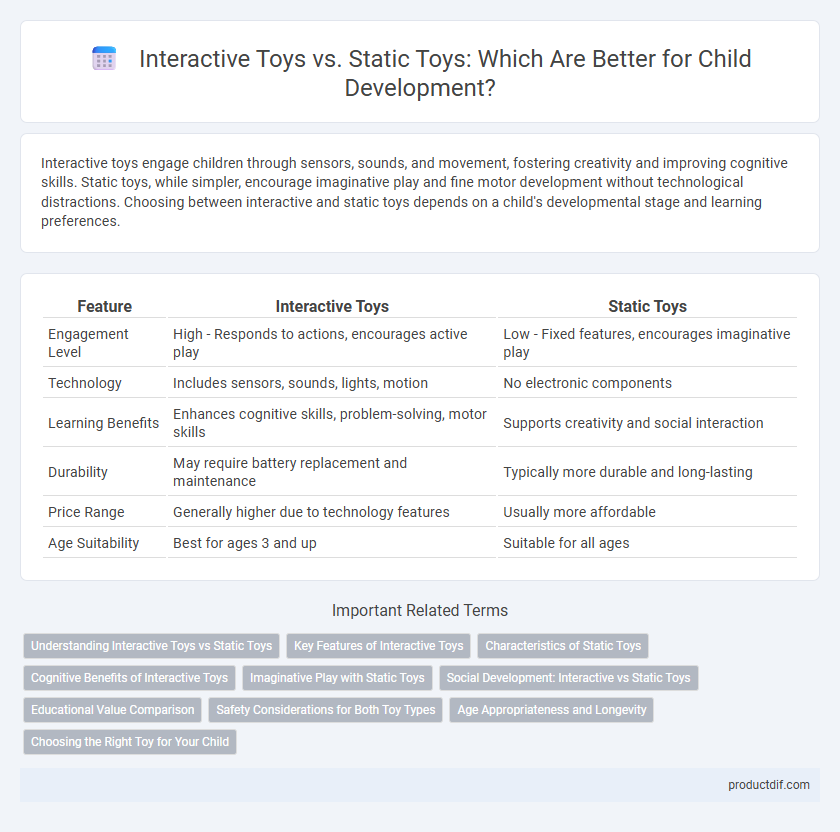Interactive toys engage children through sensors, sounds, and movement, fostering creativity and improving cognitive skills. Static toys, while simpler, encourage imaginative play and fine motor development without technological distractions. Choosing between interactive and static toys depends on a child's developmental stage and learning preferences.
Table of Comparison
| Feature | Interactive Toys | Static Toys |
|---|---|---|
| Engagement Level | High - Responds to actions, encourages active play | Low - Fixed features, encourages imaginative play |
| Technology | Includes sensors, sounds, lights, motion | No electronic components |
| Learning Benefits | Enhances cognitive skills, problem-solving, motor skills | Supports creativity and social interaction |
| Durability | May require battery replacement and maintenance | Typically more durable and long-lasting |
| Price Range | Generally higher due to technology features | Usually more affordable |
| Age Suitability | Best for ages 3 and up | Suitable for all ages |
Understanding Interactive Toys vs Static Toys
Interactive toys engage children through sensors, sounds, lights, and motion, promoting cognitive development and creativity by responding to user input. Static toys, such as puzzles or blocks, provide consistent, hands-on experiences that foster fine motor skills and imaginative play without technological components. Understanding the differences helps parents and educators select toys that match developmental needs and learning objectives.
Key Features of Interactive Toys
Interactive toys feature sensors and microprocessors that respond to touch, sound, or movement, creating an engaging play experience. These toys often include programmed voice responses, lights, and motion capabilities that stimulate cognitive development and imaginative play. Unlike static toys, their dynamic interactions promote learning through cause-and-effect and encourage social skills development.
Characteristics of Static Toys
Static toys are characterized by their unchanging structure and lack of moving parts, providing children with opportunities to engage in imaginative play without technological interaction. Typically made from durable materials like wood or plastic, these toys promote creativity and fine motor skills by encouraging open-ended use. Their simplicity fosters cognitive development by allowing children to invent scenarios and stories independently, making them valuable for early childhood learning.
Cognitive Benefits of Interactive Toys
Interactive toys enhance cognitive development by engaging multiple senses and encouraging problem-solving skills, critical thinking, and creativity. Unlike static toys, they adapt to a child's responses, promoting active learning and sustained attention. Studies show that children using interactive toys demonstrate improved memory retention and language acquisition compared to those playing solely with non-interactive toys.
Imaginative Play with Static Toys
Static toys foster imaginative play by encouraging children to create their own stories and scenarios without predefined functions or electronic prompts. These toys, such as building blocks, dolls, and figurines, stimulate creativity and cognitive development by allowing open-ended interaction and problem-solving. Research shows that static toys enhance language skills, social interaction, and emotional understanding through imaginative role-playing.
Social Development: Interactive vs Static Toys
Interactive toys enhance social development by encouraging communication, collaboration, and empathy through role-playing and shared activities. Static toys, while beneficial for solitary play and imagination, offer fewer opportunities for children to engage in social interactions and develop interpersonal skills. Research indicates that interactive toys foster stronger social bonds and improve verbal and nonverbal communication abilities in early childhood.
Educational Value Comparison
Interactive toys enhance cognitive development and problem-solving skills by offering dynamic feedback and adaptive challenges, which static toys lack. These toys stimulate creativity and social interaction through responsive features, promoting active learning and engagement. Static toys, while valuable for imaginative play, provide limited educational value compared to the formative benefits delivered by interactive toys.
Safety Considerations for Both Toy Types
Interactive toys often contain electronic components and small parts, increasing the risk of choking hazards and electrical malfunctions, so they must comply with strict safety standards such as ASTM F963 and EN71. Static toys, though simpler, require non-toxic materials and smooth edges to prevent injuries and chemical exposure, with regulations focusing on material safety and durability. Both toy types demand thorough testing for flammability, lead content, and mechanical hazards to ensure child-safe play environments.
Age Appropriateness and Longevity
Interactive toys offer dynamic engagement and adapt to a child's developmental stage, making them ideal for various age groups and promoting prolonged interest. Static toys, while simpler, often provide timeless appeal and durability, suitable for younger children or for fostering imaginative play over time. Choosing age-appropriate interactive toys can enhance cognitive skills and extend play value, whereas static toys support foundational learning and long-term use.
Choosing the Right Toy for Your Child
Interactive toys engage children through responsive features such as lights, sounds, and movement, promoting cognitive development and fine motor skills more effectively than static toys. Static toys, including puzzles and blocks, encourage creativity and imagination by allowing children to create their own play scenarios without programmed responses. Selecting the right toy depends on your child's developmental needs and interests, balancing interactive features with opportunities for open-ended play.
Interactive toys vs static toys Infographic

 productdif.com
productdif.com